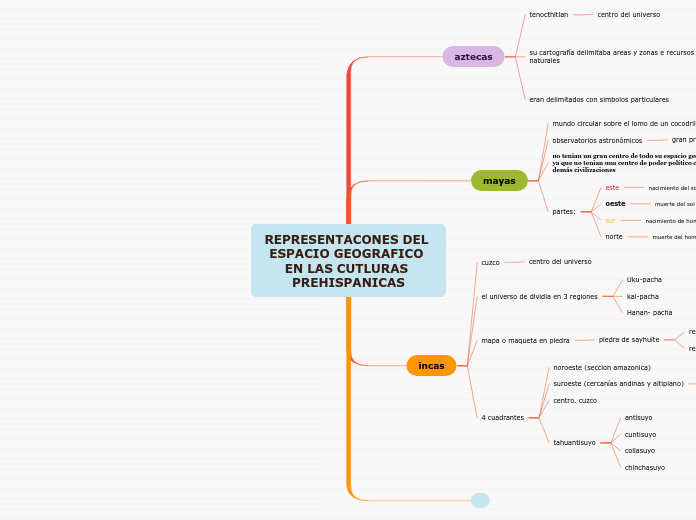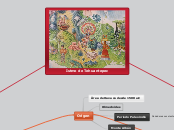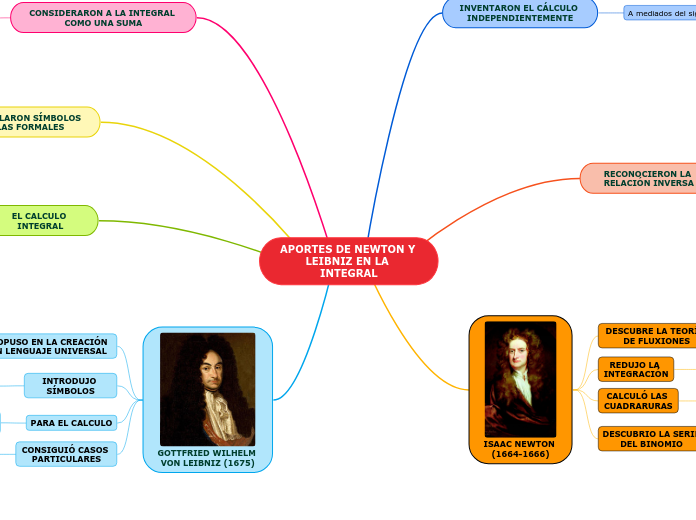REPRESENTACONES DEL ESPACIO GEOGRAFICO EN LAS CUTLURAS PREHISPANICAS
To name your story, you have to think about the overall message and what you want your audience to understand from the story. Also, make it relevant and easy to remember.
incas
The ending of a story is essential. We all know that if the ending is weak, what happened before loses its importance. So make it unpredictable, but fair. A resolved ending answers all the questions and ties up any loose threads from the plot.
4 cuadrantes
tahuantisuyo
chinchasuyo
collasuyo
cuntisuyo
antisuyo
centro. cuzco
suroeste (cercanías andinas y altiplano)
tierra de los antepasados
noroeste (seccion amazonica)
mapa o maqueta en piedra
piedra de sayhuite
representaciones de construcciones humanas
representaciónes de accidentes geograficos
el universo de dividia en 3 regiones
This is the closure section of the story.
See examples of possible outcomes below:
- all problems have been solved
- it's clear how each one of your characters ends up
- your main character is transformed by the challenge
Hanan- pacha
kai-pacha
Try answering these questions in order for you to come up with a closure:
- Have all problems been solved?
- Is it clear what happens with all your characters in the story?
- Has the challenged transformed your main character?
- How do the characters feel in the end?
Uku-pacha
Try answering these questions to come up with a closure:
- Have all the problems been solved?
- Is there a clear picture of what happens with each character in the story?
- Has the challenge transformed your main character?
- How do the characters feel in the end?
cuzco
This is the moment when the main character surpasses the last obstacle and finally faces their greatest challenge.
The climax usually follows one of these patterns:
- realization
- resolution
- choice
Type in your answer.
mayas
The middle of the story is where you add layers of complications that will lead to the end. Reveal more about the character's journey. Did their personality go through changes? How did they overcome the challenges? And as you build up the story’s central conflict, make it more personal to that character. Also, from the middle act, you have to lead into the final act.
partes:
There wouldn't be any tension and excitement in your story if there weren't any obstacles in your character's way.
norte
muerte del hombre
sur
nacimiento de hombre
oeste
muerte del sol
este
nacimiento del sol
no tenian un gran centro de todo su espacio geográfico ya que no tenian una centro de poder político como las demás civilizaciones
Your character(s) need(s) motivation in order to solve the challenge(s).
tenian como eje del mundo a un arbol
Secondary characters also might have motivs beacuse of which they may cross path with main character or which might trigger them to help the main character.
observatorios astronómicos
gran precisión en la planificación calendárica
mundo circular sobre el lomo de un cocodrilo
Each story has a main character and that character usually needs to solve a problem or challenge. The character's challenge is the one that creates tension throughout the story.
aztecas
In the beginning of the story (or the exposition), you will need to introduce the setting and characters. You might also want to introduce the main conflict. This part of the story is important because it gives the reader necessary background information and maybe even a first insight into a character’s personality.
eran delimitados con simbolos particulares
su cartografía delimitaba areas y zonas e recursos naturales
The setting (time & place) of a story can change throughout the plot.
cultivos
caminos: con huellas humanas
Sensory details include sight, sound, touch, smell, and taste. These details are important because they create depth in your setting.
See a few examples below:
- the smell of fresh bread
- the scent of freshly cut grass
- rain falling onto the windshield etc.
minas
The weather is an important element in your story because it can highly influence the ambiance and the mood of the characters.
propiedades
The time of the story can also change. It can describe the event of a single day or can include an entire year's plot. Anyway, don't forget to mention it.
mapas catastrales
tenocthitlan
Characters are essential to a good story. Usually, the protagonist(s) is/are the most affected by the plot. Introduce a character by focusing on their actions, interests, and occupation, as the physical appearance doesn't make a difference in most cases.
centro del universo
Type in the name of your character.










